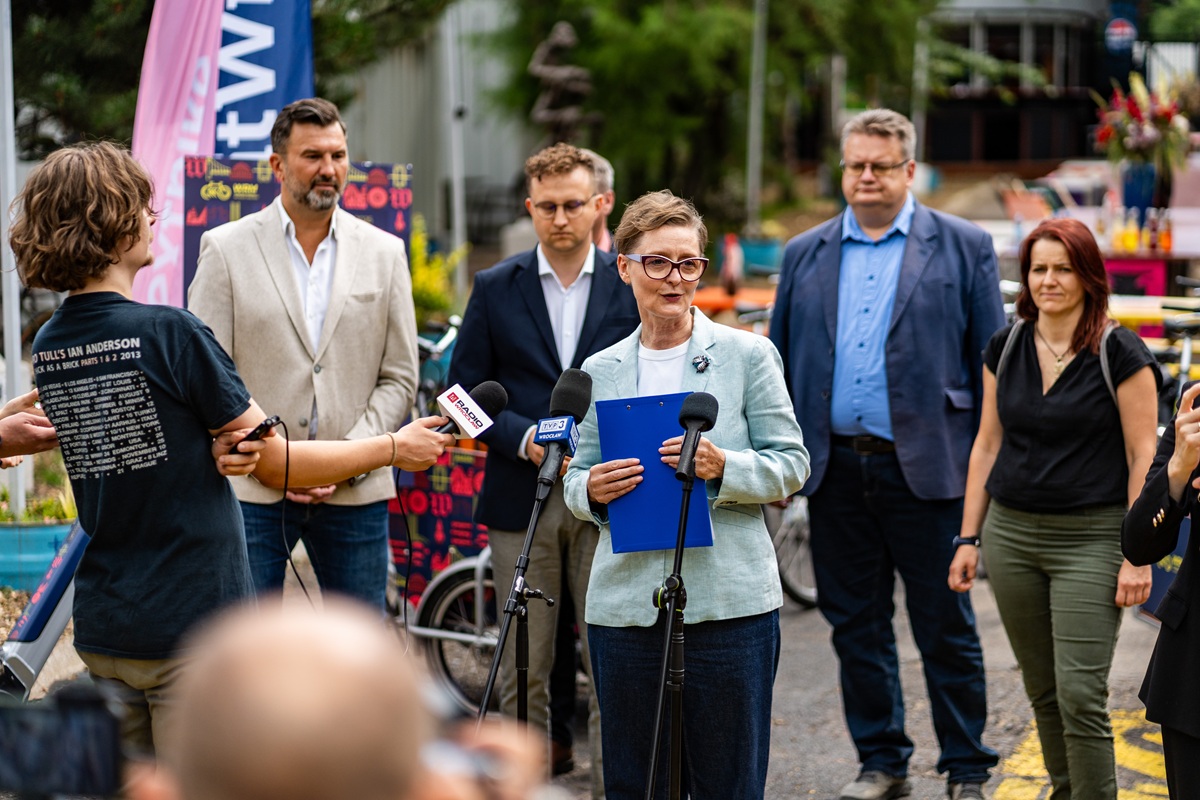
From August 1, residents of Wrocław will be able to ride lighter bicycles equipped with state-of-the-art onboard systems based on Internet of Things (IoT) technology.
The new system in Wrocław alone consists of 240 stations, and the infrastructure has been visually refreshed to better match the city’s aesthetics and its public transport network. What’s more, Wrocław City Bike (WRM) will expand into an agglomeration-wide system, covering the municipalities of Czernica, Kobierzyce, Kąty Wrocławskie, Siechnice, and Wisznia Mała.
4 Million Kilometers on Wrocław City Bikes
“In Wrocław, we have around 1,400 km of bike-friendly infrastructure — including park paths and riverside embankments — and 400 km of dedicated bike lanes. For years, Wrocław has been consistently developing its cycling infrastructure, treating bikes as an integral part of the city’s transport system. The City Bike is a key element of our transport policy. We’ve been riding it for 14 years! The WRM system continues to grow and enjoys unwaning popularity. In 2011, we started with 140 bikes; today residents can use 2,400,” says Jacek Sutryk, Mayor of Wrocław.
The bikes are brand new, and these are their first rides on Wrocław’s paths.
“These bikes are lighter and equipped with a modern system that makes GPS more precise and operation much faster. I hope residents will enjoy riding them,” adds Mayor Sutryk.
The Wrocław bike rental system has over 300,000 registered users. Last year alone, 84,000 of them made at least one rental, collectively covering almost 4 million km. On average, each trip covers 2.48 km and lasts 32.8 minutes.
“We’re happy to be back in Wrocław for another five seasons. WRM was our first system in Poland and one of the first public bike-sharing schemes in the country — launched in 2011 with 140 bikes. We’ve been proud to watch it grow almost 17-fold, working side-by-side with the city. Over this time, bikes have been rented over 15 million times, and even the temporary system from April to now has already recorded over 600,000 rentals. This shows that Wrocław residents are among the most bike-friendly in Poland, and I’m confident about the results in the coming years,” says Tomasz Wojtkiewicz, CEO of Nextbike Polska.
Tailor-Made Travel
In its new form, WRM will offer 2,400 traditional fourth-generation bikes, supplemented by 100 modern e-bikes and 34 special bikes — including cargo bikes, tandems, handbikes, and children’s bikes — available by prior reservation.
“Today WRM is more than just a bike — it’s a real alternative for everyday urban transport. We focus on a variety of models because our data clearly shows that new features — such as e-bikes — attract users and increase engagement. Freshness in the offer is what drives micromobility growth,” says Wojtkiewicz.
The agreement with Nextbike will run for five years. In the coming years, the number of stations and bikes in Wrocław will continue to grow — in 2026 by 3 stations and 30 bikes, and in 2027 by another 2 stations and 20 bikes.
WRM in the Municipalities
WRM will now go beyond the city limits, becoming the Agglomeration City Bike. This is the result of cooperation between Wrocław City Hall, the Wrocław Agglomeration Association, and neighboring municipalities.
“Two years ago, we launched a pilot City Bike project in the municipalities of Kąty Wrocławskie, Wisznia Mała, and Kobierzyce to see if residents there would rent bikes as eagerly as in Wrocław. The numbers clearly showed strong interest among people traveling in the Wrocław metropolitan area,” says Tomasz Wiśliński, President of the Wrocław Agglomeration Association.
The municipalities have now committed to joining the new system.
“Czernica, Kobierzyce, Kąty Wrocławskie, Siechnice, and Wisznia Mała will gradually launch WRM services in the coming weeks. The network will thus grow by 220 bikes and 22 new stations. This is excellent news, as expanding bike infrastructure not only supports the idea of sustainable mobility in the Wrocław metropolitan area but also strengthens relationships between local governments and residents,” adds Wiśliński.
New System, New Rules
In the updated WRM system, the payment model will change. Users will be able to rent bikes by linking a payment card in the mobile app. The previous prepayment and account top-up option will be discontinued. Existing users with this option will also need to add a payment card to rent bikes.
“Users who already have a card linked to their account don’t need to repeat the process when the new WRM launches. This change is part of system modernization aimed at simplifying the service, speeding up operations, and increasing user safety. As with many modern digital platforms, charges will be collected automatically — the app will only bill for the specific ride. This way, users can ride without worrying about topping up their account or checking their balance,” explains Wojtkiewicz.
The first 20 minutes of a ride will remain free, the next 40 minutes will cost PLN 3, and each additional hour will be PLN 6. E-bike rides will cost PLN 0.59 per started minute.
Wrocław City Bike 2024 in Numbers
-
Number of rentals: 1,559,659
-
Total users: 84,101
Most popular stations:
-
Dworzec Główny, South – 28,655
-
Dworzec Główny – 27,075
-
Plac Dominikański (Galeria Dominikańska) – 24,579
-
Szczęśliwa (Sky Tower) – 24,115
-
Legnicka (Park Magnolia) – 18,968
-
Rondo Reagana – 18,853
-
Rynek – 18,180
-
Al. Armii Krajowej / Borowska – 17,451
-
Powstańców Śląskich / Aleja Hallera – 17,421
-
Kamienna / Borowska (Aquapark) – 16,159
Month with the highest rentals: June – 222,783
Average trip distance: 2.48 km
Average rental time: 32.8 minutes
Total usage time this year: 51 million minutes
Total distance traveled: 3.77 million km
New stations:
-
Airport
-
Jerzmanowska/Adamczewskich intersection
-
Wrocław Żerniki railway station
-
Marszowicka Street
-
Ułańska Street
-
Wrocław Wojszyce railway stop
-
Koreańska Street (Park na Skraju)
-
Wrocław Wojnów railway stop
-
Międzyrzecka Street (under Aleja Wielkiej Wyspy – already partially operating)
-
Awicenny/Chachaja intersection
 Polski
Polski English
English Deutsch
Deutsch Українська
Українська